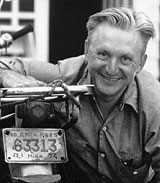Robert M. Pirsig
Critique

Born
1928
Publications
Novels, philosophy
Writing languages
English
Literature
• Zen and the Art of Motorcycle Maintenance (1974)
Novels
• Zen and the Art of Motorcycle Maintenance (1974)
American Literature
• Zen and the Art of Motorcycle Maintenance (1974)
Philosophical Fiction
A writer of unusual value
He's written two novels. If you can call them novels. Maybe you'd prefer to call them works of philosophy, thinly—very thinly—disguised as fiction.
Or perhaps you'd be more accurate to call them memoirs, heavy on recalling some rather abstruse philosophical discussions Robert Maynard Pirsig has had with himself.
Or better yet, call the first of the two books, Zen and the Art of Motorcycle Maintenance: An Inquiry into Values, a massive bestseller that struck the nascent New Age movement of the 1970s like the clap of a single hand and has infuriated professional novelists and philosophers with its continued popularity ever since.
Not that Pirsig hasn't also won some academic credibility over the years. Recently an international philosophical conference has been held to discuss his Metaphysics of Quality, the philosophical system he introduced in Zen and confusingly explicated in Lila: An Inquiry into Morals. His first novel has become required reading in some introductory philosophy courses.
Those two novels are about it in terms of major writing output for Pirsig. However, his own life is also somewhat of a novel, though not necessarily in this order:
Born in Minneapolis. Said to be very bright. Enters the University of Minnesota at age 15 to study biochemistry but flunks out (as a result of philosophical concerns about science that stymied him, he implies in Zen). Drifts around the Midwest. Joins the army, serves in Korea. Returns to complete his Bachelor's degree in philosophy. Studies Oriental philosophy in India. Enrols as a journalism student and runs off with another student, a married woman, to Reno for a divorce. Works as a dealer in Nevada. Lives in Mexico for about a year. Marries. Returns to United States, completes a Masters degree in journalism. Has two sons. Freelances as a technical editor. Teaches English at Montana State College and the University of Illinois. Studies for a philosophy doctorate a the University of Chicago but has a mental breakdown (from obsessing over his "Quality" project, if the Zen character Phaedrus faithfully represents him). More breakdowns in the early 1960s. Shock therapy. Recovers. Writes Zen and the Art of Motorcycle Maintenance. Published in 1974 to great acclaim. Plans to sail around the world with his wife. Ends up crossing to England with another woman. Divorces. Remarries. First-born son Chris, who was also a character in Zen, is stabbed to death during a mugging in 1979. With second wife in 1981, Pirsig has another child, Nell, who he says has Chris's spirit ("spirit" in a broad sense). All three sail to Norway and Sweden where they live for a couple of years. In 1991 he publishes Lila, a more detailed examination of his philosophy, to somewhat less acclaim, although the book is studied by his admirers.
Whew. Since then Pirsig has variously been thought to have killed himself (not true), to be working on his intellectual projects out of the limelight (no doubt), and sailing around the Atlantic (true some of the time). Not writing novels. Waiting for the world to understand his insights as put forth in his two books.
There are some signs of the latter occurring. And opposite signs that the world is passing his ideas by. Nothing and no one is certain, least of all anyone who reads his books today.
My view is that Pirsig was, no doubt, on to a piece of something important, an intellectual sea change that was occurring in the second half of the twentieth century, and his novels captured part of the zeitgeist of the 1960s and 1970s. It was a piece of a critique against established thinking, which was under fire during that tumultuous time—namely, the metaphysical and analytical approach to understanding the world and its inhabitants, that disconnected us from world. But Pirsig blew that little piece up into an entire movement, a philosophy of sheer value—which thrilled some people then but looks rather silly to others now.
...and thus I find myself writing as obliquely about the big questions as Pirsig does. Which is my other criticism of his work. It's not creative in the literary sense of creating real characters in situations readers can imagine themselves experiencing—but I can live with that. The novel form has many creative uses, including the presentation of ideas in a story format. But then the story should be helpful in making the ideas more alive than they would be if presented directly, as in dull essays or articles.
Despite the thousands or more who would disagree with me, claiming they have been deeply moved by Pirsig's words, I find his ideas are presented vaguely and erratically in his two novels. His second, Lila, especially is intellectually denser than any philosophical treatise I've read. Pirsig seems to use fictional characters not to make his ideas more vivid but to excuse himself for sliding off into incomprehensibility whenever the ideas don't quite work themselves out.
Still, I suspect there is something of value (so to speak) buried in those pages. So, if you haven't already, give Pirsig a try yourself and find out whether you fall into the group that finds his words maddening or the group that finds them enlightening.
— Eric
Critique

